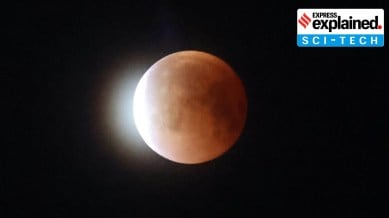Blood Moon visible in India: What is it and why you should care, in 5 points
Total Lunar Eclipse September 2025 Time: How is a Blood Moon related to the colour of the sky and of sunrises and sunsets? What is a lunar eclipse in the first place? We explain, in 5 points.

A special cosmic show was seen on Sunday night (September 8), when around 9 pm, Asia, Australia, and parts of Africa witnessed a ‘Blood Moon’, or a total lunar eclipse in which the moon appeared red. Viewers also saw the earth’s shadow creep across the lunar surface.
Why does this eclipse event cause a Blood Moon to appear? How is a Blood Moon related to the colour of the sky and of sunrises and sunsets? What can a Blood Moon tell us about the health of the earth? We explain, in 5 points.
First, what is a lunar eclipse?
Depending on whether the earth is bang in the middle of the sun and the moon or somewhere nearabouts, the lunar eclipse can be total or partial.
When the moon is passing through the inner, darkest part of the earth’s shadow, called umbra, it appears dimmer. When it passes through the penumbra, or the outer part of the shadow, the dimming can be too small to be noticed prominently.
Unlike a solar eclipse, a lunar eclipse is safe to watch with the naked eye.
What is the Blood Moon?
The Blood Moon is visible during a total lunar eclipse. As the earth is placed between the sun and the moon, only some sunlight, filtered from the earth’s atmosphere, reaches the moon. When sunlight collides with the molecules suspended in the air, blue light scatters away easily, and only the red light reaches the moon, making it look red.
What can the colour of the Blood Moon tell us?
The more pollutants in the air light finds to collide with, the redder the Blood Moon will appear. The lunar eclipse is linked with superstitions in several cultures, but has not scientifically been found to cause harm. However, since the redness of the moon depends on pollutants in the air, it can tell us something about past harmful events.
For example, in 2023, the University of Geneva in Switzerland studied Medieval-era records of Blood Moons to check the timings of volcanic eruptions. A volcanic eruption would have left ash and gas in the atmosphere, which would have made the Blood Moons appear darker.
According to an article in Space.com, the scientists examined accounts from 1100 to 1300 AD, and “linked five dark and two reddish lunar eclipses to major eruptions during the High Medieval Period. Dark lunar eclipses were observable for three to 20 months after an eruption.”
How is the Blood Moon linked to the colour of the sky?
The same phenomenon of light scattering is behind the blue colour of the sky and the red-orange glory of the sunrise and sunset. This phenomenon is called the Rayleigh scattering, named after the British physicist John William Strutt, 3rd Baron Rayleigh, who first explained it.
Put simply, when sunlight enters the earth’s atmosphere, it is scattered by the oxygen and nitrogen molecules. Blue light, with a shorter wavelength, scatters more, and as it comes into our eyes from all directions, the sky looks blue.
During sunrise and sunset, the sun is nearer to the horizon, and thus, light is passing through a denser layer of the atmosphere. In such a scenario, blue light is scattered too much to be visible, and only the longer-wavelength red, orange, yellow, etc. reach us.
How was the Blood Moon viewed on Sunday?
As compiled by the BBC, the timings in India were:
8:58 PM IST – Penumbral eclipse begins
9:57 PM IST – Partial eclipse begins
11:00 PM IST – Total eclipse begins
11:41 PM IST – Maximum eclipse
12:22 AM IST – Total eclipse ends
1:26 AM IST – Partial eclipse ends
2:25 AM IST – Penumbral eclipse ends
One could see it from a tall building, or any location with an uninterrupted view of the moon. No special equipment was needed to get a good look.